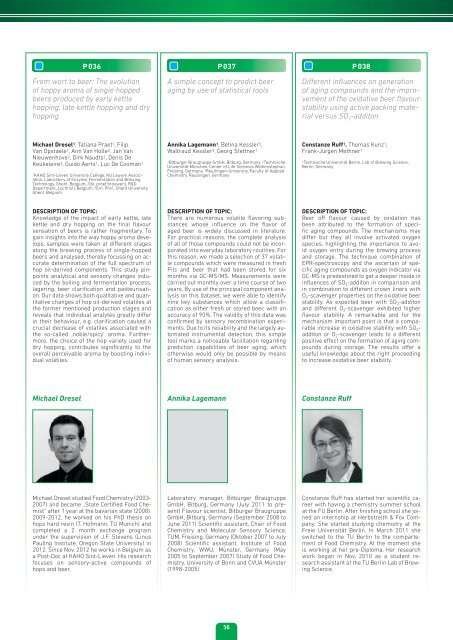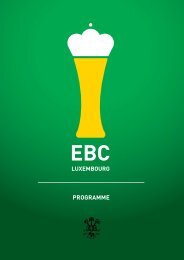please click here for download. - the 34th European Brewery ...
please click here for download. - the 34th European Brewery ...
please click here for download. - the 34th European Brewery ...
You also want an ePaper? Increase the reach of your titles
YUMPU automatically turns print PDFs into web optimized ePapers that Google loves.
P 036<br />
From wort to beer: The evolution<br />
of hoppy aroma of single hopped<br />
beers produced by early kettle<br />
hopping, late kettle hopping and dry<br />
hopping<br />
P 037<br />
A simple concept to predict beer<br />
aging by use of statistical tools<br />
P 038<br />
Different influences on generation<br />
of aging compounds and <strong>the</strong> improvement<br />
of <strong>the</strong> oxidative beer flavour<br />
stability using active packing material<br />
versus SO 2 -additon<br />
Michael Dresel 1 , Tatiana Praet 1 , Filip<br />
Van Opstaele 1 , Ann Van Holle 2 , Jan Van<br />
Nieuwenhove 2 , Dirk Naudts 2 , Denis De<br />
Keukeleire 3 , Guido Aerts 1 , Luc De Cooman 1<br />
1KAHO Sint-Lieven University College, KU Leuven Association,<br />
Laboratory of Enzyme, Fermentation and Brewing<br />
Technology, Ghent, Belgium, 2 De ‚proef‘brouwerij, R&D<br />
Department, Lochristi, Belgium, 3 Em. Prof., Ghent University,<br />
Ghent, Belgium<br />
Annika Lagemann 1 , Betina Kessler 2 ,<br />
Waltraud Kessler 3 , Georg Stettner 1<br />
1Bitburger Braugruppe GmbH, Bitburg, Germany, 2 Technische<br />
Universität München, Center of Life Sciences Weihenstephan,<br />
Freising, Germany, 3 Reutlingen-University, Faculty of Applied<br />
Chemistry, Reutlingen, Germany<br />
Constanze Ruff 1 , Thomas Kunz 1 ,<br />
Frank-Jürgen Methner 1<br />
1Technische Universität Berlin, Lab of Brewing Science,<br />
Berlin, Germany<br />
DESCRIPTION OF TOPIC:<br />
Knowledge of <strong>the</strong> impact of early kettle, late<br />
kettle and dry hopping on <strong>the</strong> final flavour<br />
sensation of beers is ra<strong>the</strong>r fragmentary. To<br />
gain insights into <strong>the</strong> way hoppy aroma develops,<br />
samples were taken at different stages<br />
along <strong>the</strong> brewing process of single-hopped<br />
beers and analysed, t<strong>here</strong>by focussing on accurate<br />
determination of <strong>the</strong> full spectrum of<br />
hop oil-derived components. This study pinpoints<br />
analytical and sensory changes induced<br />
by <strong>the</strong> boiling and fermentation process,<br />
lagering, beer clarification and pasteurisation.<br />
Our data shows both qualitative and quantitative<br />
changes of hop oil-derived volatiles at<br />
<strong>the</strong> <strong>for</strong>mer mentioned production stages and<br />
reveals that individual analytes greatly differ<br />
in <strong>the</strong>ir behaviour, e.g. clarification caused a<br />
crucial decrease of volatiles associated with<br />
<strong>the</strong> so-called ‚noble/spicy‘ aroma. Fur<strong>the</strong>rmore,<br />
<strong>the</strong> choice of <strong>the</strong> hop variety used <strong>for</strong><br />
dry hopping, contributes significantly to <strong>the</strong><br />
overall perceivable aroma by boosting individual<br />
volatiles.<br />
DESCRIPTION OF TOPIC:<br />
T<strong>here</strong> are numerous volatile flavoring substances<br />
whose influence on <strong>the</strong> flavor of<br />
aged beer is widely discussed in literature.<br />
For practical reasons, <strong>the</strong> complete analysis<br />
of all of those compounds could not be incorporated<br />
into everyday laboratory routines. For<br />
this reason, we made a selection of 37 volatile<br />
compounds which were measured in fresh<br />
Pils and beer that had been stored <strong>for</strong> six<br />
months via GC-MS/MS. Measurements were<br />
carried out monthly over a time course of two<br />
years. By use of <strong>the</strong> principal component analysis<br />
on this dataset, we were able to identify<br />
nine key substances which allow a classification<br />
as ei<strong>the</strong>r fresh or stored beer, with an<br />
accuracy of 90%. The validity of this data was<br />
confirmed by sensory recombination experiments.<br />
Due to its reliability and <strong>the</strong> largely automated<br />
instrumental detection, this simple<br />
tool marks a noticeable facilitation regarding<br />
prediction capabilities of beer aging, which<br />
o<strong>the</strong>rwise would only be possible by means<br />
of human sensory analysis.<br />
DESCRIPTION OF TOPIC:<br />
Beer off flavour caused by oxidation has<br />
been attributed to <strong>the</strong> <strong>for</strong>mation of specific<br />
aging compounds. The mechanisms may<br />
differ but <strong>the</strong>y all involve activated oxygen<br />
species, highlighting <strong>the</strong> importance to avoid<br />
oxygen entry during <strong>the</strong> brewing process<br />
and storage. The technique combination of<br />
EPR-spectroscopy and <strong>the</strong> ascertain of specific<br />
aging compounds as oxygen indicator via<br />
GC-MS is predestined to get a deeper inside in<br />
influences of SO 2 -additon in comparison and<br />
in combination to different crown liners with<br />
O 2 -scavenger properties on <strong>the</strong> oxidative beer<br />
stability. As expected beer with SO 2 -additon<br />
and different O 2 -scavenger exhibited higher<br />
flavour stability. A remarkable and <strong>for</strong> <strong>the</strong><br />
mechanism important point is that a comparable<br />
increase in oxidative stability with SO 2 -<br />
additon or O 2 -scavenger leads to a different<br />
positive effect on <strong>the</strong> <strong>for</strong>mation of aging compounds<br />
during storage. The results offer a<br />
useful knowledge about <strong>the</strong> right proceeding<br />
to increase oxidative beer stability.<br />
Michael Dresel<br />
Annika Lagemann<br />
Constanze Ruff<br />
Michael Dresel studied Food Chemistry (2003-<br />
2007) and became „State Certified Food Chemist“<br />
after 1 year at <strong>the</strong> bavarian state (2008).<br />
2009-2012, he worked on his PhD <strong>the</strong>sis on<br />
hops hard resin (T. Hofmann, TU Munich) and<br />
completed a 2 month exchange program<br />
under <strong>the</strong> supervision of J.F. Stevens (Linus<br />
Pauling Institute, Oregon State University) in<br />
2012. Since Nov. 2012 he works in Belgium as<br />
a Post-Doc at KAHO Sint-Lieven. His research<br />
focuses on sensory-active compounds of<br />
hops and beer.<br />
Laboratory manager, Bitburger Braugruppe<br />
GmbH, Bitburg, Germany (July 2011 to present)<br />
Flavour scientist, Bitburger Braugruppe<br />
GmbH, Bitburg, Germany (September 2008 to<br />
June 2011) Scientific assistant, Chair of Food<br />
Chemistry and Molecular Sensory Science,<br />
TUM, Freising, Germany (Oktober 2007 to July<br />
2008) Scientific assistant, Institute of Food<br />
Chemistry, WWU, Münster, Germany (May<br />
2005 to September 2007) Study of Food Chemistry,<br />
University of Bonn and CVUA Münster<br />
(1998-2005)<br />
Constanze Ruff has started her scientific career<br />
with having a chemistry summer school<br />
at <strong>the</strong> FU Berlin. After finishing school she joined<br />
an internship at Herbstreith & Fox Company.<br />
She started studying chemistry at <strong>the</strong><br />
Freie Universität Berlin. In March 2011 she<br />
switched to <strong>the</strong> TU Berlin to <strong>the</strong> compartement<br />
of Food Chemistry. At <strong>the</strong> moment she<br />
is working at her pre-Diploma. Her research<br />
work began in Nov. 2010 as a student research<br />
assistant at <strong>the</strong> TU Berlin Lab of Brewing<br />
Science.<br />
56





